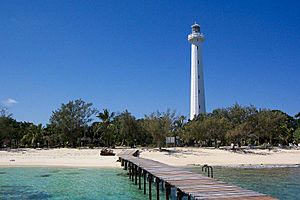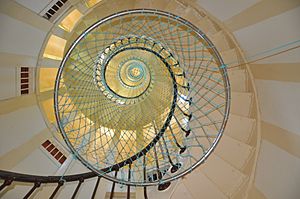Amédée Lighthouse facts for kids
 |
|
|
|
|
| Location | Nouméa, New Caledonia |
|---|---|
| Coordinates | 22°28′38″S 166°28′05″E / 22.477330°S 166.467952°E |
| Year first constructed | 1865 |
| Construction | cast iron tower |
| Tower shape | 16-side tapered tower with balcony and lantern |
| Markings / pattern | white tower and lantern |
| Height | 56 metres (184 ft) |
| Focal height | 52 metres (171 ft) |
| Original lens | 250 mm lens |
| Range | 20 nautical miles (37 km; 23 mi) |
| Characteristic | Fl (2) W 15s. |
| Admiralty number | K4802.1 |
| NGA number | 3644 |
| ARLHS number | NCA-001 |
The Amédée Lighthouse (which in French is Phare Amédée) is a special lighthouse made of iron. It stands on Amédée Island, about 24 kilometers away from Nouméa in New Caledonia.
This lighthouse is quite unique! Its metal parts were made in Paris, France, in 1862. The whole tower was even put together in Paris first, just to show how strong it was.
After its Paris debut, the lighthouse was taken apart. All its pieces, weighing almost 388,000 kilograms, were sent by boat down the River Seine to the port of Le Havre. From there, they traveled all the way to New Caledonia.
Standing 56 meters tall, with 247 steps inside, it's one of the tallest lighthouses in the world. It was also the very first lighthouse in France to be built entirely from metal. The first stone was laid on January 18, 1865. The light was first turned on on November 15, 1865. This day was special because it was the saint's day of Empress Eugénie, who was the wife of Napoléon III.
The Amédée Lighthouse helps ships find their way into the Boulari passage. This is one of only three natural openings in the coral reef around New Caledonia. Far away, in the English Channel, there's another lighthouse called the Roches-Douvres Light. It looks just like the Amédée Lighthouse! Today, the Amédée Lighthouse is a very popular place for tourists to visit.
Contents
Building the Amédée Lighthouse
Why a Lighthouse Was Needed
In 1859, the leader of New Caledonia, Jean-Marie Saisset, asked the government in Paris for a lighthouse. He wanted it to guide ships safely into the port of Nouméa. At that time, Nouméa was called Fort-de-France.
The lighthouse was especially important because New Caledonia was becoming a new place for French prisoners. More ships meant a greater need for clear guidance into the harbor.
A New Way to Build
New Caledonia didn't have many skilled workers like stonemasons. So, the French lighthouse group suggested building the lighthouse from pre-made iron parts. This was a new idea! The first time this method was used was in 1841 for the Morant Point Lighthouse in Jamaica.
The Minister for the Navy, Prosper de Chasseloup-Laubat, agreed to the plan. He chose Léonce Reynaud to design the lighthouse. Reynaud was famous for designing many lighthouses and even the original Gare du Nord train station in Paris.
Smart Design Choices
Reynaud decided to make the lighthouse parts from "puddled iron." This was a special type of iron. He also made the lighthouse narrow enough so it could be built without needing lots of scaffolding.
He added a clever new feature: the inside structure was separate from the outside. This was to protect the lighthouse from rust in the humid, tropical weather of New Caledonia. The plans for this amazing design were shown at a big exhibition in London in 1862.
Its Journey to New Caledonia
A company called Rigolet made all the metal parts in just four months. Then, they had to build the lighthouse near their factory in Paris. This was to prove it was stable and strong.
The lighthouse stayed in Paris from July 1862 to June 1864. It became a popular sight for people in Paris to visit. The pieces were then packed into 1,200 crates, weighing 388 tons. They were shipped to Le Havre and finally arrived in New Caledonia in November 1864.
Putting It All Together
The lighthouse was built on Amédée Island by a team of French soldiers and local workers. A man named Louis-Émile Bertin led the construction. He later became a very important ship designer for France and Japan.
The light was turned on for the first time on November 15, 1865. This date was chosen because it was the saint's day of Empress Eugénie, the wife of Napoléon III.
Important Bird Area
Amédée Island is a small island, about 4 hectares in size. It has been named an Important Bird Area (IBA) by BirdLife International. This is because it's home to a large group of fairy terns that come here to lay their eggs and raise their young. In 2012, about 240 fairy terns were counted on the island.
See also
 In Spanish: Faro Amédée para niños
In Spanish: Faro Amédée para niños
Images for kids




